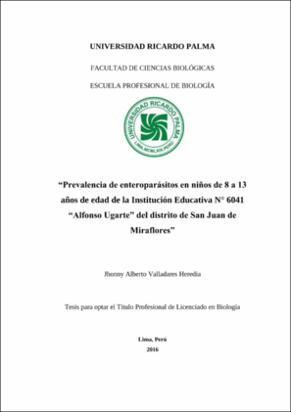Mostrar el registro sencillo del ítem
“Prevalencia de enteroparásitos en niños de 8 a 13 años de edad de la Institución Educativa N° 6041 “Alfonso Ugarte” del distrito de San Juan de Miraflores”
| dc.contributor.author | Valladares Heredia, Jhonny Alberto | |
| dc.date.accessioned | 2016-08-10T20:24:27Z | |
| dc.date.available | 2016-08-10T20:24:27Z | |
| dc.date.issued | 2016 | |
| dc.identifier.uri | https://hdl.handle.net/20.500.14138/699 | |
| dc.description.abstract | Las enteroparasitosis intestinales constituyen un problema de salud pública en Perú, debido a que estos parásitos pueden ingresar al organismo por vía oral y hábitos higiénico-sanitarios deficientes que facilitan su transmisión y conservación. Cuando la carga de dichos parásitos es considerablemente alta o se acompaña de alteraciones en la inmunidad del hospedero, se pueden producir complicaciones que comprometen seriamente la salud del paciente. Sabemos que el control farmacológico de las parasitosis es efectivo y seguro. No obstante, sin autocuidado y mantenimiento sostenible de buenas condiciones higiénico-sanitarias, no es posible su erradicación. Considerando lo mencionado anteriormente, desarrollaré la presente investigación en una población escolar de la Institución Educativa N° 6041 “Alfonso Ugarte” del distrito San Juan de Miraflores para determinar la prevalencia de parasitosis intestinales. Se eligió una muestra representativa conformada de 116 niños de 8 a 13 años. Las muestras fecales obtenidas fueron analizadas utilizando: examen macroscópico, método directo, método de Parodi Alcaraz y test de Graham. El 85.3% de los alumnos examinados resultaron parasitados. La incidencia parasitaria fue mayor en mujeres (86.8%) comparado a los hombres (83.6%). La frecuencia parasitaria de acuerdo al Monoparasitismo de los grupos taxonómicos fueron 35.3% del Phylum Amoebozoa, 3.4% del Phylum Metamonada, 3.4% del Phylum Platyhelminthes, 0.9% del Phylum Bigyra y 0.9% del Phylum Nematoda, con las especies Entamoeba coli, Giardia lamblia, Hymenolepis nana, Blastocystis hominis y Enterobius vermicularis, respectivamente. La mayor frecuencia correspondiente al Biparasitismo fue la asociación de los Phyla Metamonada y Amoebozoa con 32.8%. La mayor frecuencia correspondiente al Triparasitismo fue la asociación de los Phyla Metamonada, Amoebozoa y Platyhelminthes con 1.7%. The intestinal enteroparasites constitute a public health problem in Peru, due to these parasites can enter the body by mouth and hygienic habits-poor health that facilitate its transmission and conservation. When the burden of such parasites is considerably high or is accompanied by alterations in the immunity of the host, it can produce complications which seriously compromise the health of the patient. We know that the pharmacological control of the parasitosis is effective and safe. However, self-care and sustainable maintenance of good hygienic and sanitary conditions, it is not possible to its eradication. Considering the above, I will develop this research in a school population of the Educational Institution N° 6041 "Alfonso Ugarte" of the district San Juan de Miraflores to determine the prevalence of intestinal parasitism. I chosen a representative sample consisted of 116 children 8 to 13 years old. Stool samples obtained were analyzed using: macroscopic examination, direct method, Parodi Alcaraz’s method and Graham’s test. The 85.3% of the students examined were parasitized. The parasitic incidence was higher in women (86.8%) compared to men (83.6%). The frequency of parasites according the Monoparasitism of taxonomic group was 35.3% of the Phylum Amoebozoa, 3.4% of the Phylum Metamonada, 3.4% of the Phylum Platyhelminthes, 0.9% of the Phylum Bigyra and 0.9% of the Phylum Nematoda, with the species Entamoeba coli, Giardia lamblia, Hymenolepis nana, Blastocystis hominis and Enterobius vermicularis, respectively. The highest frequency corresponding the Biparasitism was the association of the Phyla Metamonada and Amoebozoa with 32.8%. The highest frequency corresponding the Triparasitismo was the association of the Phyla Metamonada, Amoebozoa and Platyhelminthes with 1.7%. | es_ES |
| dc.description.sponsorship | Submitted by Wong Rafael (rafel_wl@hotmail.com) on 2016-08-10T20:24:27Z No. of bitstreams: 1 valladares_ja.pdf: 1896661 bytes, checksum: 83643f582fe3638b0db2be755e1bf676 (MD5) | es_ES |
| dc.description.sponsorship | Made available in DSpace on 2016-08-10T20:24:27Z (GMT). No. of bitstreams: 1 valladares_ja.pdf: 1896661 bytes, checksum: 83643f582fe3638b0db2be755e1bf676 (MD5) Previous issue date: 2016 | es_ES |
| dc.description.sponsorship | Restored into DSpace on 2016-12-07T20:39:32Z (GMT). | es_ES |
| dc.description.uri | Tesis | es_ES |
| dc.format | application/pdf | |
| dc.language.iso | spa | |
| dc.publisher | Universidad Ricardo Palma - URP | es_ES |
| dc.rights | info:eu-repo/semantics/openAccess | |
| dc.rights.uri | https://creativecommons.org/licenses/by-nc-nd/4.0/ | |
| dc.source | Repositorio Institucional - URP | es_ES |
| dc.subject | enteroparasitismo | es_ES |
| dc.subject | prevalencia | es_ES |
| dc.subject | G. lamblia | es_ES |
| dc.subject | E. coli | es_ES |
| dc.subject | H. nana | es_ES |
| dc.subject | B. hominis | es_ES |
| dc.subject | E. vermicularis | es_ES |
| dc.subject | enteroparasitism | es_ES |
| dc.subject | prevalence | es_ES |
| dc.subject | G. lamblia | es_ES |
| dc.subject | E. coli | es_ES |
| dc.subject | H. nana | es_ES |
| dc.subject | B. hominis | es_ES |
| dc.subject | E. vermicularis | es_ES |
| dc.title | “Prevalencia de enteroparásitos en niños de 8 a 13 años de edad de la Institución Educativa N° 6041 “Alfonso Ugarte” del distrito de San Juan de Miraflores” | es_ES |
| dc.type | info:eu-repo/semantics/bachelorThesis | |
| thesis.degree.discipline | Biología | es_ES |
| thesis.degree.grantor | Universidad Ricardo Palma. Facultad de Ciencias Biológicas. Escuela Profesional de Biología | es_ES |
| thesis.degree.level | Título Profesional | es_ES |
| thesis.degree.name | Licenciado en Biología | es_ES |
| dc.publisher.country | PE | es_ES |
| renati.type | https://purl.org/pe-repo/renati/type#tesis | |
| renati.level | https://purl.org/pe-repo/renati/nivel#tituloProfesional | |
| renati.discipline | 511206 | |
| dc.type.version | info:eu-repo/semantics/publishedVersion |
Ficheros en el ítem
Este ítem aparece en la(s) siguiente(s) colección(ones)
-
Biología [176]


